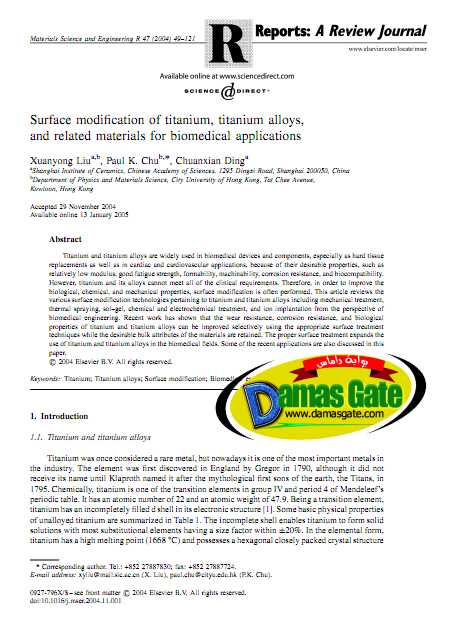Surface modification of titanium, titanium alloys, and related materials for biomedical applications

Introduction
Titanium and titanium alloys
Titanium was once considered a rare metal, but nowadays it is one of the most important metals in
the industry. The element was first discovered in England by Gregor in 1790, although it did not
receive its name until Klaproth named it after the mythological first sons of the earth, the Titans, in
1795. Chemically, titanium is one of the transition elements in group IV and period 4 of Mendeleef’s
periodic table. It has an atomic number of 22 and an atomic weight of 47.9. Being a transition element,
titanium has an incompletely filled d shell in its electronic structure [1]. Some basic physical properties
of unalloyed titanium are summarized in Table 1. The incomplete shell enables titanium to form solid
solutions with most substitutional elements having a size factor within 20%. In the elemental form,
titanium has a high melting point (1668 8C) and possesses a hexagonal closely packed crystal structure
Titanium and titanium alloys are widely used in biomedical devices and components, especially as hard tissue replacements as well as in cardiac and cardiovascular applications, because of their desirable properties, such as relatively low modulus, good fatigue strength, formability, machinability, corrosion resistance, and biocompatibility. However, titanium and its alloys cannot meet all of the clinical requirements. Therefore, in order to improve the biological, chemical, and mechanical properties, surface modification is often performed. This article reviews the various surface modification technologies pertaining to titanium and titanium alloys including mechanical treatment, thermal spraying, sol-gel, chemical and electrochemical treatment, and ion implantation from the perspective of biomedical engineering. Recent work has shown that the wear resistance, corrosion resistance, and biological properties of titanium and titanium alloys can be improved selectively using the appropriate surface treatment techniques while the desirable bulk attributes of the materials are retained. The proper surface treatment expands the use of titanium and titanium alloys in the biomedical fields. Some of the recent applications are also discussed in this paper.
Download
http://s18.alxa.net/s18/srvs2/02/003...f.titanium.rar

Introduction
Titanium and titanium alloys
Titanium was once considered a rare metal, but nowadays it is one of the most important metals in
the industry. The element was first discovered in England by Gregor in 1790, although it did not
receive its name until Klaproth named it after the mythological first sons of the earth, the Titans, in
1795. Chemically, titanium is one of the transition elements in group IV and period 4 of Mendeleef’s
periodic table. It has an atomic number of 22 and an atomic weight of 47.9. Being a transition element,
titanium has an incompletely filled d shell in its electronic structure [1]. Some basic physical properties
of unalloyed titanium are summarized in Table 1. The incomplete shell enables titanium to form solid
solutions with most substitutional elements having a size factor within 20%. In the elemental form,
titanium has a high melting point (1668 8C) and possesses a hexagonal closely packed crystal structure
Titanium and titanium alloys are widely used in biomedical devices and components, especially as hard tissue replacements as well as in cardiac and cardiovascular applications, because of their desirable properties, such as relatively low modulus, good fatigue strength, formability, machinability, corrosion resistance, and biocompatibility. However, titanium and its alloys cannot meet all of the clinical requirements. Therefore, in order to improve the biological, chemical, and mechanical properties, surface modification is often performed. This article reviews the various surface modification technologies pertaining to titanium and titanium alloys including mechanical treatment, thermal spraying, sol-gel, chemical and electrochemical treatment, and ion implantation from the perspective of biomedical engineering. Recent work has shown that the wear resistance, corrosion resistance, and biological properties of titanium and titanium alloys can be improved selectively using the appropriate surface treatment techniques while the desirable bulk attributes of the materials are retained. The proper surface treatment expands the use of titanium and titanium alloys in the biomedical fields. Some of the recent applications are also discussed in this paper.
Download
http://s18.alxa.net/s18/srvs2/02/003...f.titanium.rar